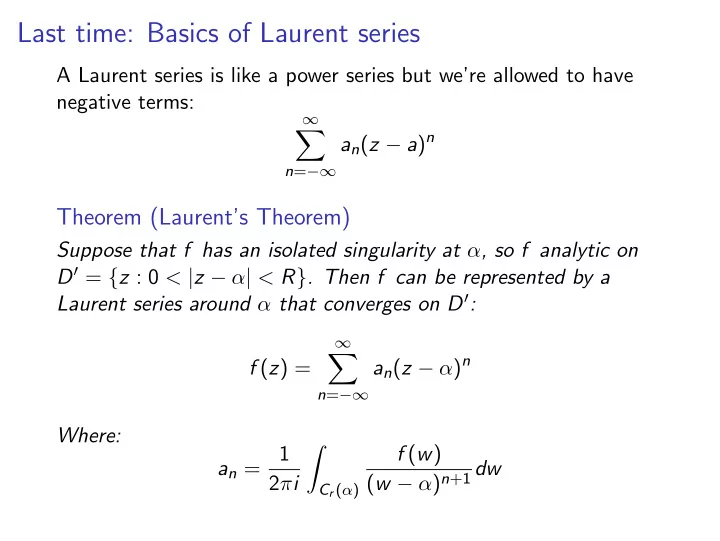

Last time: Basics of Laurent series A Laurent series is like a power series but we’re allowed to have negative terms: ∞ � a n ( z − a ) n n = −∞ Theorem (Laurent’s Theorem) Suppose that f has an isolated singularity at α , so f analytic on D ′ = { z : 0 < | z − α | < R } . Then f can be represented by a Laurent series around α that converges on D ′ : ∞ � a n ( z − α ) n f ( z ) = n = −∞ Where: 1 f ( w ) � a n = ( w − α ) n +1 dw 2 π i C r ( α )
What’s left to cover: 11.5+11.6 Classification of singularities 11.7+11.8 Calculating residues at poles 12+12.1 Residue Theorem 12.2 Application of Residue Theorem to real integrals Definition (Residue) Let f have an isolated singularity at α , and Laurent expansion: ∞ � a n ( z − α ) n f ( z ) = n = −∞ Then a − 1 is called The residue of f at α , and written Res { f ; α } . Awkward ordering in notes: The end of 11 is really about finding Residues, but we only care about these because of the Residue Theorem.
To fix this, changing order of lectures To motivate the material at the end of Section 11, going to cover the Residue Theorem first. Today Residue Theorem: Proof + first examples Thursday Classifying Singularities + finding residues Next Tuesday Applying Residue Theorem to real integrals Next Thursday Revision; focus on last two weeks The material next lecture will make applying Residue Theorem easier in nice cases.
Theorem (The Residue Theorem) Let D be a simply connected region containing a simple positively oriented contour γ . Suppose f is analytic on D except for finitely many singularities β 1 , . . . , β n , none of which like on γ . Then � f ( z ) dz = 2 π i × ( sum of the residues of f at the β i inside γ ) γ Proof. The proof is really putting together things we’ve already done: ◮ Deform contour so one singularity in each piece ◮ Expand f in Laurent series ◮ Use formula for a − 1 / our first important example
Every mother on Christmas morning Every lecturer when they prove the big theorem of the module
Using the Residue Theorem Show you understand and check hypotheses! 1. Find the bad points (isolated singularities) β i of f 2. Draw picture showing γ and bad points to see which are inside 3. Find the residues at the bad points inside γ Examples; let c = 5 e it (0 ≤ t ≤ 2 π ) dz 1. � z 2 ( z − 3) 3 c dz 2. � tan( z ) c c z 3 cos(1 / z ) dz 3. � Take-away: Using Residue Theorem from definition can be slightly painful; can we find residue without finding whole Laurent expansion?
Recommend
More recommend